
John Woodall's Medicine Chest Ingredients: 1 2 3 4 Next>>
John Woodall's Medicine Chest Ingredients, Page 2
John Woodall's Medicine Chest
At the

John Woodall
beginning of the 17th century, health care provisions for ships undertaking long voyages varied widely, with vessels often being poorly prepared to care for sick and wounded sailors. The East India Trading company, who had large numbers of ships sailing around the world, recognized this problem and were among the first English companies to take action to standardize medical care at sea. They did this by appointing John Woodall as "the first surgeon-general to the East India Company (EIC), on the recommendation of his patron Sir Thomas Smith, Governor of the Company. He was responsible for the selection of surgeons, the supply of surgeons' chests to the East Indiamen, and for the treatment of injured workmen at the company's small dockside hospitals"1.
While he did much to improve the medical treatment for the EIC, two of his greatest contributions to the history of sea surgery were the creation of the first English sea surgeon's handbook, the surgions mate, and the standardization of the medicine chests that each surgeon left port with. The book was written to support the chest and provided detailed descriptions of the various medicines Woodall suggested that a surgeon should take to sea with him.
Not long after Woodall's reorganization of the EIC's medical practices, the British government began to take an interest in overhauling their sea medicine practices. In 1626, "the Privy Council decided to pay the Barber-Surgeons Company fixed allowances to furnish medical chests for both the army and the navy"2. The Barber-Surgeons Company asked the EIC to oversee the provision of his chests, which fell to Woodall. As Woodall explained, he 'had the whole ordering, making and appointing of His
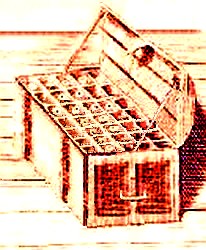
Source: British Museum
Medicine Chest,
From
The Quack
Doctor
Outwitted (1710)
(Note: Not a Sea Surgeon's Chest)
Highnesse Military provisions for Surgery, both for his Land and Sea-service".3 Although Woodall was dismissed from the EIC in 1635 as way for the company to save money4, he continued to supply them medicine chests until his death in 1643.
Woodall's medicine chest contained slots for 160 assigned medicines. As noted previously, there are 124 unique medicines in the diagram, with the balance being medicines found elsewhere in the chest. However, Woodall lists a great many more remedies in his book, the location of which in the chest are apparently left "to the Surgeons experimentall ordering and view."5 John Kirkup found "some 270 items of vegetable, animal and mineral origin" in the section of the surgions mate titled 'Medicines Physicall and Chirurgicall'.6 Another author, Joan Druett, identified 281 medicines in Woodall's book, of which "145 are herbal, while a total of 204 have a biotic [living] content."7 (Woodall lists medicines in several sections of the book which may account for this discrepancy between Druett and Kirkup.)
We will be focusing in this article on the ingredients shown in Woodall's medicine chest, leaving the remaining medicines and ingredients for a future article.
1 Kevin Brown, Poxed and Scruvied at Sea, p. 36; 2,3,4 John Kirkup's Introduction to the reprinting of John Woodall's book, the surgions mate, p. xv; 5 John Woodall, the surgions mate, 1639 Edition, diagram opp. p. 26; 6 Kirkup's Intro to Woodall, p. xviii; 7 Joan Druett, Rough Medicine, p. 52
The Design of a Medicine Chest
While
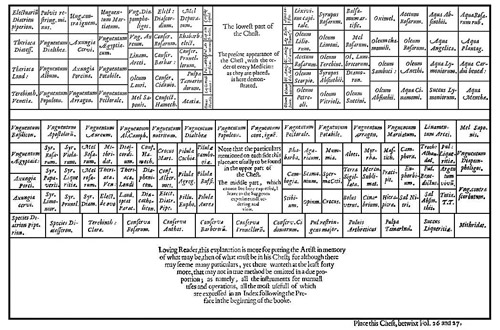
John Woodall's Medicine Chest Diagram, From the surgions mate, opp. page 26 (1639)
John Woodall goes into great detail about many of the medicines in his chest, he does not give much information about the actual design of the chest. The best he does is provide a diagram of his medicine chest, provided as a reference for his sea surgeons. A small version of this can be seen at right. In the preface to his reprinting of the surgions mate, John Kirkup explains that this is a folding plan included beginning with the 1639 edition of Woodall's book, showing that "each medicine is placed specifically in the upper, middle or lower part of the chest".1
Since the diagram seen here is difficult to read (a larger version appears on the next page), but is relevant to our discussion, let me reprint the relevant parts. The open box in the middle of the upper chart explains that it is, "The lowest part of the Chest." The open box in the middle says, "Note that the particulars mentioned on each side this place, are usually to be found in the upper part of the Chest. The middle part, which cannot bee here expressed, I leave to the Surgeons experimentall ordering and view." So it is clear there were three layers to his chest, with the middle one containing medicines that each individual surgeon chose to put there.
Although Woodall doesn't go into detail on his apothecary chest design, some of the other surgeons provided some insight into the design of their medicine chests.

Sea Surgeon John Moyle
John Moyle gave a great deal of advice to sea surgeons on the design of their medicine chest. He suggested not putting their regular medicines in the bottom of the surgeon's tool chest like some merchant-men's surgeons did. (They likely did this to save on the cost of buying more than one chest.) Moyle reasoned that placing medicines in the tool chest was "altogether inconvenient (if you can avoid it) for there must be a preposterous displacing of things [surgeon's tools] before you can come at the Medicines you would have, therefore if I am worthy to advise you, let not your Drugs be in your Chyrurgery [Surgeon's Tool] Chest; but have Partitions all over the bottom [of another chest - the medicine chest], and let those partitions be bigger than them at top; and in them place your greatest Jars and Glasses (and especially your Oyles and Corrosive Medicaments, that if they should spill or break, they cannot fall on others to dammage them)."2
Surgeon William Fabry makes a similar point, noting that the medicine chest 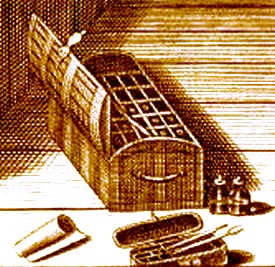
Source: British Museum
Medicine Chest with Partitions in Top Section,
From
The Infallible Montebank; Or Quack Doctor (1690)
(Note: This Is Not a Sea Surgeon's Medicine Chest) "ought to be so divided into Partitions and Classes, that all confusion and intermixing of Medicines may be avoided, and the Virtue and Propriety of each preserved."4
Moyle also warns "not to have drawing Boxes at the Ends of the bottom of your Chest [a box on rails that can be slid from side to side or removed in order to access something below3], as some [surgeons medicine chests] use[d] to have, and carry their Seeds and other things in them; for when you shall need any thing that is in them, you must take out several Medicines that stand in the bottom of the Chest before them; which Pots or Glasses will be in danger of breaking, especially if there goes a great Sea, and the Ship rouls."5
Because Moyle's description indicates compartments in the bottom of the chest with a drawer hanging over the middle, it would seem that the bottom part of the chest was built into a drawer that slid out. This is similar to many of the smaller, land-based medicine chests from this era, which makes sense. The drawing boxes (which he advised against including as shown in the previous paragraph) would have slid on the edge of the top of the drawer.
Moyle goes on to explain that medicine chests "usually [have] a hanging drawer under the middle of the top partitions, where some Chyrurgions use to keep their Instruments; Let that be for your Emplasters."6 Emplasters [also called plasters] were linens with medicines on them. Such a drawer would provide a nice buffer between the top layer of liquid medicines and the bottom and also prevent any leakage from liquid items placed inside this drawer. (Moyle is one of the most eminently practical sea surgical writers from this time.) It is interesting to note that he doesn't indicate that there would be drawers hanging under the edges of the top partition, only the middle. Since we have no sea-surgeon's chest from this era to examine, we can't be sure how they were designed.
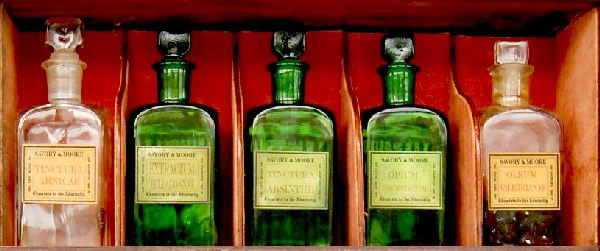
Large Square Bottles in a 19th. Century Medicine Chest. The Bottle Stoppers Are NOT Typical
of late 17th/early 18th Century Medicine Chests Which would Have Cork Stoppers with Leather Tied Over Them
In the top section of the medicine chest, Moyle suggested the surgeon put "the remainder of your bigger Jars and Glasses, because they are the bigger partitions... in the partitions of your top Drawers you may place some four, in others more, of your small square Glasses and Jars; as four ounces, two ounces, and [single] ounces; and every thing written upon, and account
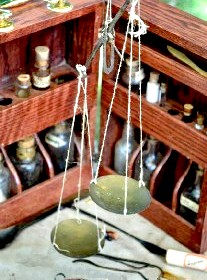
Photo: Michael Colossimo
Mission's (Small) Medicine Chest With
Balance Scale and Apothecary Tools
taken in your book, you will know readily where to find each Medicine in the bottom of any partition, although its Lybel should be lost"7.
Moyle is easily able to place multiple bottles of medicine in the same partition because of the types of bottles he advises. As he explains in another book, "you had better have square double Glass Jars and Bottles, than Gallipots; for these will fit the partitions in your Chest better than the others, and indeed will preserve your Medicines cooler and better."8 Again, we see Moyle's practical understanding at work.
Similar to Woodall's medicine chest chart, Moyle suggested that the surgeon "keep account in your [surgeon's log] Book whereabout each Medicine stands, that you may either go or send for the Medicine you want and find it (as it were) in the dark."9 Leaving no space wasted, he advises the surgeon to have his "small Weights and Scales be fixed to the inside of the Lid of your Chest, as also your Electuary and Unguent Spatula's, and Tyle to mix Boluses on; with other Necessaries."10 Although he is placing tools in the medicine chest, they are the tools that are related to the medicines themselves; the surgeon's operating tools are clearly to be kept in the 'Chyrugeon's' chest.
1 John Kirkup's Introduction to the reprinting of John Woodall's book, the surgions mate, p. xviii; 2 John Moyle, Abstractum Chirurgæ Marinæ, p. 15-6; 3 Jim McGavic, On Making a Medicine Chest, Pyracy Pub Forum, 3/27/13; gathered 8/7/14, 4 Guliielm. Fabritius Hildanus aka. William Fabry. Cista Militaris, Or, A Military Chest, Furnished Either for Sea or Land, p. 9; 5 Moyle, Abstractum, p. 15; 6 Moyle, Abstractum, p. 16; 7 Moyle, Abstractum, p. 16-7; 8 John Moyle, The Sea Chirurgeon, p. 40; 9,10 Moyle, Abstractum, p. 16;
Categories of Medicines in the Chest
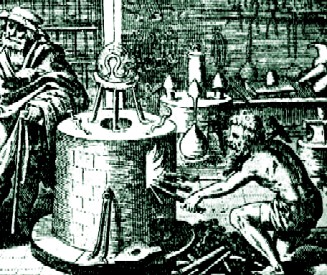
Distilling a Complex Medicine, From Tripus Aureus
by Lucas Jennis (1618)
Medicines were subdivided into a variety of categories during this time. Every author seemed to have their own method, some of them being quite complex. William Fabry's book divides the medicines into 18 different classes which included Oils, Plasters, Gums, Syrups, Gums, Spices, Herbs, Distilled Waters and similar categories that identified the substance of the medicine.1 Herbalist Nicholas Culpeper used a similar strategy in his index. In his text, Culpeper also identifies many substances by their humoral properties - whether the medicine is hot, dry, wet or cold and to what degree.2 While these divisions are interesting in some ways, they are either implicit in the name of the medicine or would require a whole separate article to explain.
Most authors identified a medicinal substance as being simple or compound. Simple medicines are those that used directly as they are found - such as roots, leaves, fruits, seeds, bark and minerals. Compound medicines were those that require preparation by apothecaries and usually contain multiple ingredients. Woodall has a variety of each type in his chest, although many of those seen here are compound. This is probably due to the fact that simples were raw herbs, vegetables and fruits and would begin to deteriorate after a four or five weeks.
1 Guliielm. Fabritius Hildanus aka. William Fabry. Cista Militaris, Or, A Military Chest, Furnished Either for Sea or Land, 1674 Edition, p. 13-21; 2 See Nicholas Culpeper, Pharmacopœia Londinesis, 1649 Edition;

